Banana Peppers or Pepperoncini: Can You Taste the Difference?
Comparing peppers like banana and pepperoncini can be quite enlightening for food enthusiasts.
Yellow-green gems add zesty flavors to countless dishes across global cuisines.
Many cooks reach for these tangy additions when creating Mediterranean salads or Italian antipasto platters.
The slight heat from both varieties wakes up taste buds without overwhelming sensitive palates.
Despite similar appearances, each pepper carries its own distinct flavor profile and culinary heritage.
The fascinating world of these mild peppers reveals much about food traditions and agricultural practices that have evolved over centuries.
Read on as we slice into the subtle distinctions that make each pepper uniquely delicious.
What Are Banana Peppers?
Banana peppers (or yellow wax peppers or banana chilis) are a popular mild chili pepper known for their crisp texture and versatile flavor. They come in two main varieties: hot and sweet.
Both are similar in size, about 2 to 3 inches long, but differ in spiciness and color.
Sweet banana peppers are mild and slightly tangy, making them great for fresh eating, pickling, or adding a subtle flavor to dishes.
Hot banana peppers, also called Hungarian wax peppers, pack more heat (up to 15,000 Scoville Heat Units) but still maintain a mild sweetness.
Banana peppers originally come from South America but now grow in many places around the world including China and India.
Their name makes perfect sense once you see them - these yellow, elongated peppers truly look just like bananas!
Varieties Of Banana Peppers
Banana peppers come in two types: hot and sweet banana peppers. Check below table for more details.
| Feature | Hot Banana Peppers | Sweet Banana Peppers |
| Taste | Spicy | Sweet |
| Color (Immature) | Dark green | Light green |
| Size | 2-3 inches | 2-3 inches |
| Spiciness Level (SHU) | Up to 15,000 (about 30x sweeter than sweet variety) | Very mild |
Exploring Pepperoncini Peppers
Pepperoncini originated in Italy and Greece, earning names like sweet Italian peppers, golden Greek peppers, and Tuscan Peppers. Many people don't know that in Italy, the term actually refers to hot chili peppers, with locals calling our familiar pepperoncini "Friggitello" instead.
For those who want just a hint of heat without overwhelming spiciness, pepperoncini sits perfectly on the heat scale just above bell peppers and banana peppers.
The color serves as a spice indicator; green immature pepperoncini pack the most heat, gradually becoming milder as they ripen to a deep red.
Pepperoncini Pepper Varieties
Greek and Italian pepperoncini peppers are often considered regional varieties of the same pepper type with some subtle differences. They are showed in a table below.
| Feature | Greek Pepperoncini | Italian Pepperoncini |
| Size | Shorter (usually around 2 inches) | Longer and sometimes larger |
| Flavor Profile | Sweeter, milder, less bitter | Slightly more bitter, tangy |
| Heat Level | Mild | Mild to moderate |
Banana Peppers and Pepperoncini Compare
Banana and pepperoncini are different, and with this comparison table, you can easily tell the apart from now on.
| Feature | Banana Peppers | Pepperoncini |
| Origin | South America | Italy and Greece |
| Varieties | Hot and sweet banana peppers | Italian and Greek varieties |
| Scoville Heat Units | 0–up to 15000 SHU (yellow <100 SHU) | 100–500 SHU |
| Color | Yellow, green, orange, red | Yellow-green to red |
| Skin Texture | Smooth, thick skin | Slightly wrinkled, thin skin |
| Shape | Long, curved with pointed ends | Crimped, folded with rounded ends |
| Taste | Sweeter | Juicier, slightly bitter |
| Maturity Color Notes | Varies widely, from green to red | Mature peppers tend to have a deep red hue |
| Durability in Cooking | Thick walls hold up well for stuffing | Thin skin better for chopping, less durable when cooked |
Color and Maturity
The color range of banana peppers spans from yellow and green to orange and red as they mature. Immature banana peppers are usually green, turning yellow and eventually red when fully ripe.
Pepperoncini peppers also shift color with maturity, moving from yellow-green to a deeper red hue. However, mature pepperoncini tend to have a more consistent deep red color compared to banana peppers, which can vary more broadly.
Skin Texture and Durability
Banana peppers have smooth, glossy, and thick skin, which makes them sturdy and ideal for dishes that require stuffing or cooking without the pepper breaking apart.
In contrast, pepperoncini peppers have thinner, slightly wrinkled skin that is more delicate. This thinner skin lends itself better to chopping and adding fresh or pickled peppers to dishes as flavor enhancers rather than being used as a vessel for stuffing.
Shape and Physical Appearance
Banana peppers are long and curved with pointed ends, resembling the shape of a banana, which is how they got their name. Pepperoncini peppers, however, have a distinct bulbous shape with crimped or folded sides and rounded ends.
This shape often reminds people of small bell peppers, giving them a different visual appeal compared to the slender banana pepper.
Taste Profile
Both banana peppers and pepperoncini share sweet and tangy flavor notes, but there are subtle differences in taste. Banana peppers are generally sweeter with a mild tanginess, making them popular for fresh eating and pickling.
Pepperoncini peppers have a juicier texture and carry a slight bitterness along with their sweetness, which adds complexity and depth to dishes where they are used.
Culinary Uses and Serving Options
Banana peppers and pepperoncini are both widely used in pickling but differ in other culinary applications due to their physical properties.
Banana peppers’ thick walls make them excellent for stuffing with meats, cheeses, or vegetables without falling apart during cooking. They are also commonly chopped and added to sandwiches, pizzas, and salads.
Pepperoncini, with their thinner skin and juicier flesh, are often used stuffed with cheese, meats, or vegetables but are also popular chopped to add a bright, slightly bitter flavor to various dishes. Their delicate texture means they are less ideal for stuffing in recipes requiring longer cooking times.
Nutritional Benefits
Both peppers provide health benefits, packed with vitamins A and C, fiber, calcium, and antioxidants that support overall wellness and reduce certain disease risks. Banana peppers contain magnesium, which may help regulate blood sugar levels and blood pressure.
They also have a slightly higher calorie content than pepperoncini. Conversely, pepperoncini peppers contain fewer calories but offer a rich mineral profile that can aid weight management and provide essential nutrients.
Pickling and Preservation of Banana Pepper and Pepperoncini
Here are steps to pickling and preserving these peppers.
Popular Dishes with Banana Pepper and Pepperoncini
Pepperoncini and banana peppers may seem similar, but once you learn their differences, a whole world of tasty recipes opens up. These mild peppers can turn ordinary meals into something special with very little effort.
Italian Sub Sandwich
This Italian recipe fits the bill perfectly. The combo of meat, cheese and veggies with banana peppers packs so much flavor in each bite, giving your mouth a gentle warmth throughout. Wrapping this tasty sandwich in plastic and popping it in the fridge keeps it fresh for 2-3 days.
Stuffed Banana Peppers With Hot Sausage
Banana peppers make fantastic vessels for delicious stuffing, especially when filled with hot sausage for a tasty low-carb meal. Their mild flavor pairs perfectly with the spicy sausage inside, creating a juicy and tender dish that goes wonderfully with rice or pasta.
You can add melted mozzarella on top for extra flavor.
5-Ingredient Pepperoncini Chicken
Mississippi pot roast might sound complicated, but this dish only needs five basic ingredients: chicken, pepperoncini, butter, garlic, and ranch seasoning. Making it couldn't be more straightforward - just toss everything together and let the magic happen.
Those zesty pepperoncini peppers mix with rich garlic notes to create a flavor that will make anyone come back for seconds.
Instant Pot Mississippi Roast
Mississippi roast in an instant pot should be on your menu soon. This delicious recipe doesn't get the attention it deserves based on its name alone.
Tender beef meets zesty pepperoncini peppers for a perfect balance of flavors that will make your taste buds dance. The pressure cooking method breaks down the meat until it practically falls apart with each bite.
Substitutions for Banana Pepper and Pepperoncini
Both banana peppers and pepperoncini are mild, tangy peppers often used in pickling, salads, sandwiches, and as toppings. When you don’t have either on hand, there are several good substitutes depending on the dish and desired flavor:
For Banana Peppers
This is a table summarizing the substitutes for banana peppers.
| Substitute | Description | Uses |
| Cubanelle Peppers | Sweet, mild flavor with thin, slightly wrinkled skin; larger than banana peppers. | Cooking, stuffing, pickling |
| Sweet Italian Peppers | Similar color and sweetness; shorter and thicker; crunchy texture and mild flavor. | Fresh eating, roasting, salads |
| Anaheim Peppers | Mild to medium heat; larger size; slightly smoky flavor. | Cooked dishes needing mild spice |
| Yellow Bell Peppers | Sweeter and milder with thick flesh; no heat; lacks banana pepper tanginess. | Raw or cooked dishes needing sweetness and crunch |
For Pepperoncini
Check out this table to find out what can replace pepperoncini peppers.
| Substitute | Description | Uses |
| Mild Banana Peppers | Closest substitute in size, mild heat, and tangy flavor. Works well fresh or pickled. | Salads, sandwiches, antipasto |
| Pickled Cherry Peppers | Tangy, slightly spicy, crunchy; smaller and rounder. Great pickled garnish or antipasto. | Pickled dishes, garnishes |
| Anaheim Peppers | Mild heat, slightly smoky flavor; larger and less tangy than pepperoncini. | Cooked or pickled recipes |
| Pickled Jalapeños | Stronger heat but share vinegary tang; use sparingly to avoid overpowering heat. | Spicy pickled dishes |
Got Questions? We’ve Got Solutions
1. Where do these peppers come from?
Banana peppers originate from Hungary and South America, while pepperoncini peppers (also called Tuscan peppers) come from Italy and Greece.
2. Which pepper is spicier?
Pepperoncini peppers are slightly spicier, measuring 100-500 Scoville units, while banana peppers are milder at 0-500 Scoville units. Both are considered mild compared to jalapeños, which measure 2,500-8,000 units.
3. How can I tell them apart in the store?
Banana peppers are typically smoother, straighter, and have a more yellow color. Pepperoncini peppers are usually more wrinkled, slightly curved, and have a greenish-yellow hue.
4. Can I substitute one for the other in recipes?
Yes, you can substitute them in most recipes. The flavor difference is subtle, with pepperoncini being slightly tangier and banana peppers being a bit sweeter.

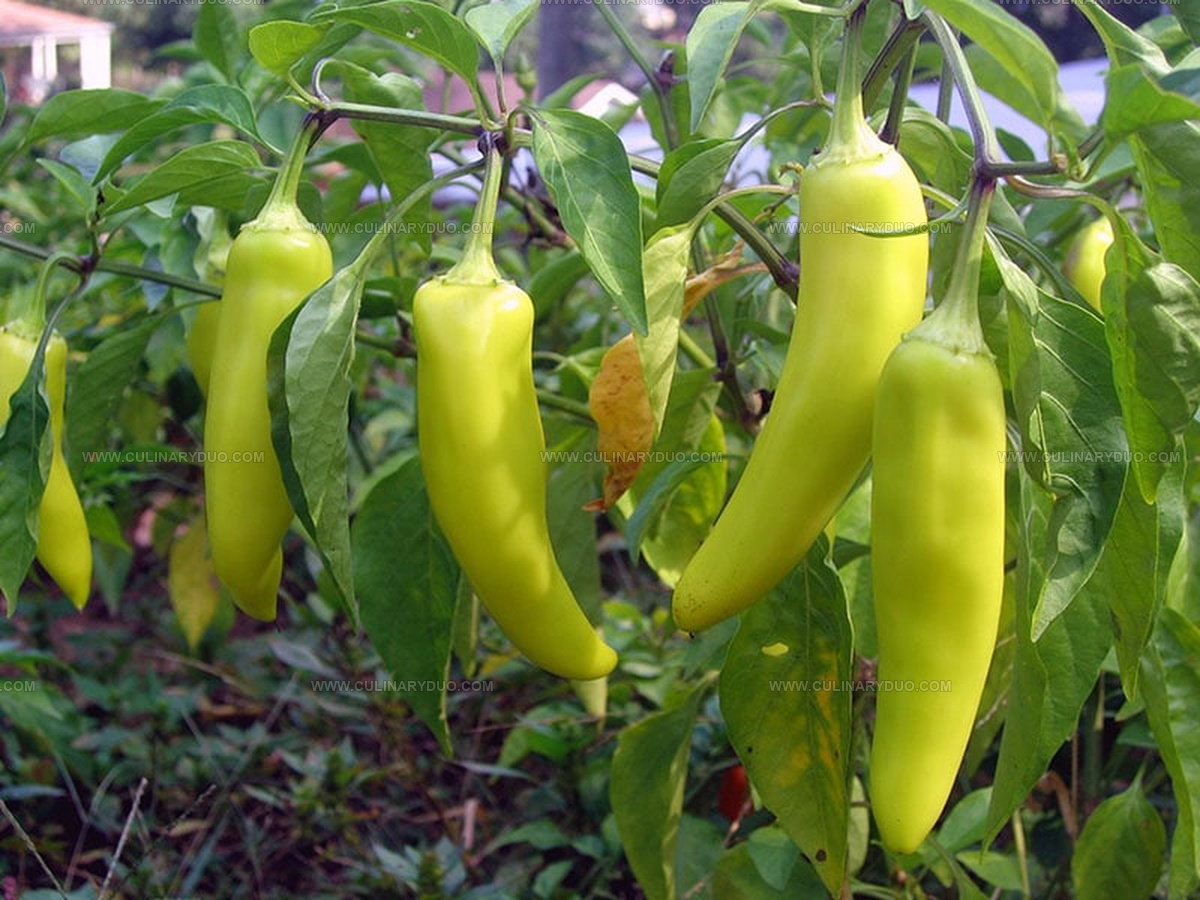
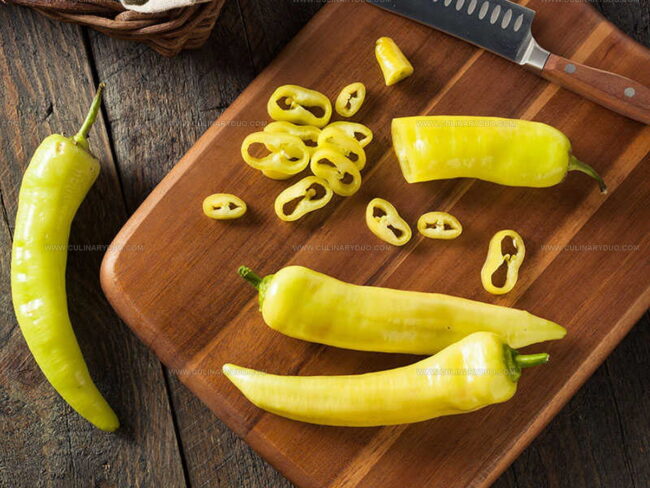
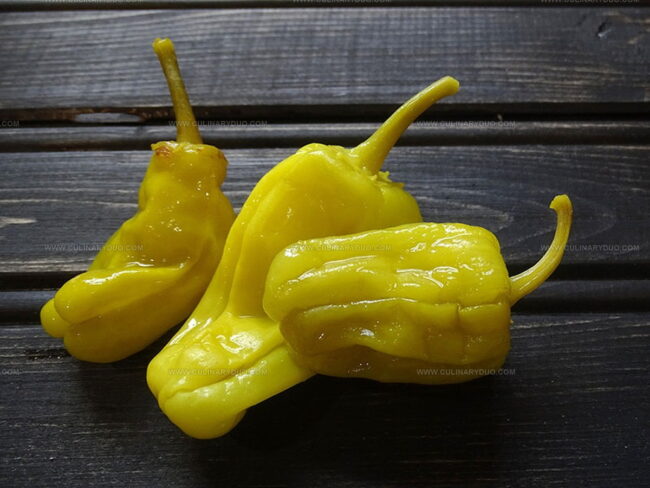
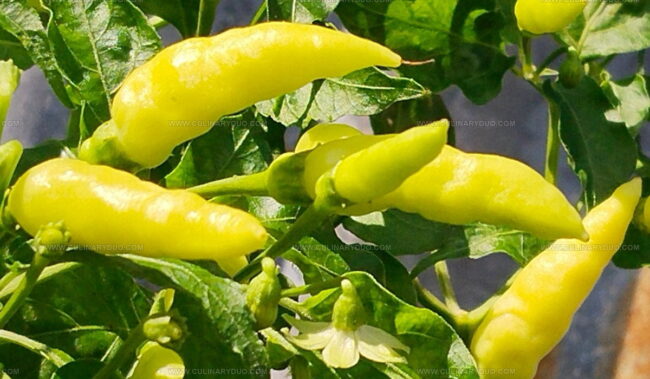
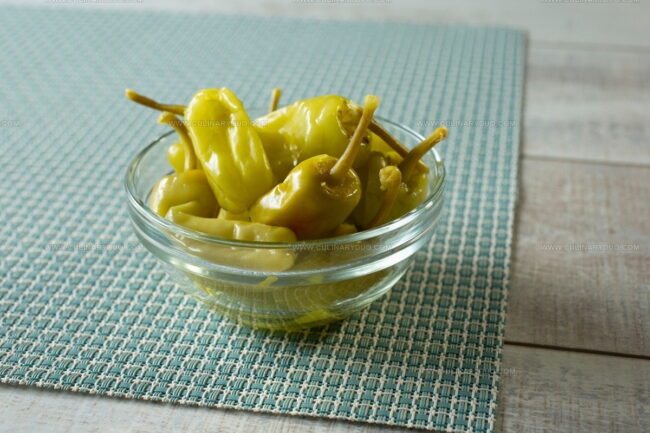
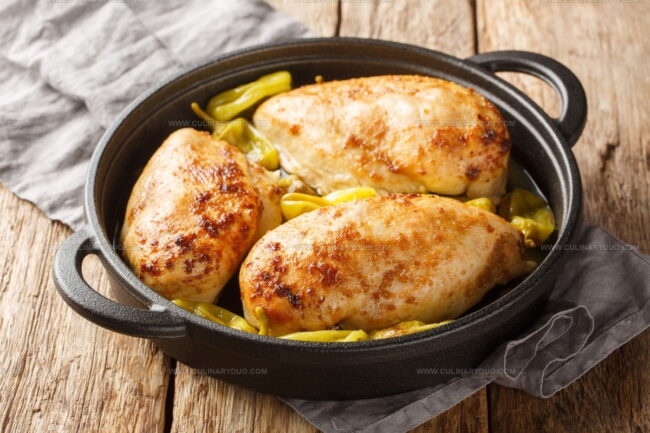
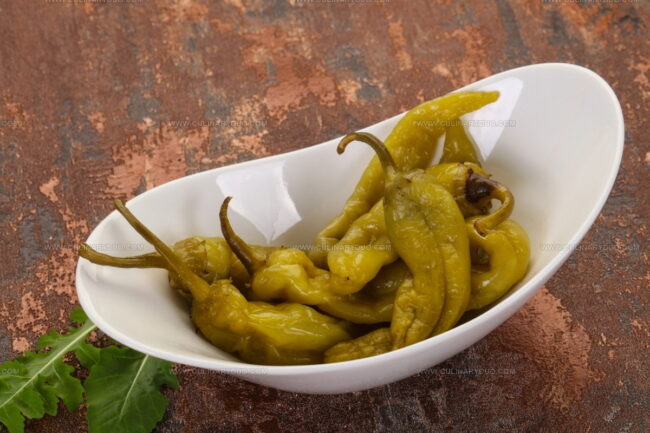
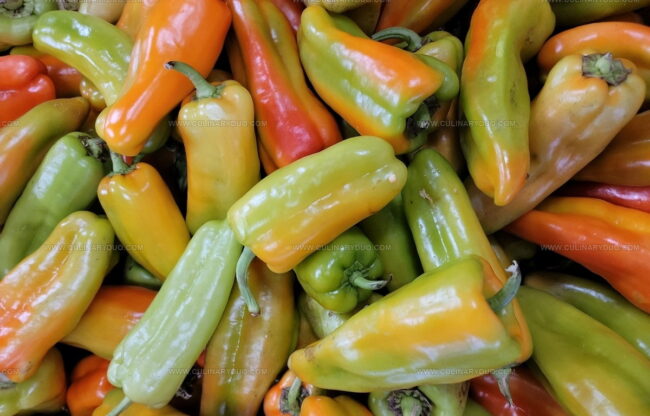
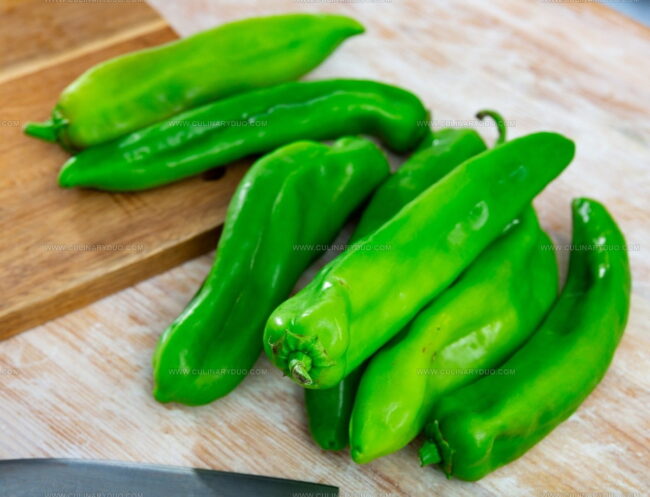
Natalie Brooks
Co-Founder & Content Strategist
Expertise
Education
eCornell
Natalie brings the vibrant, plant-powered side to Culinary Duo. After earning her Plant-Based Nutrition Certificate from eCornell, she combined her love for fresh ingredients with a passion for storytelling, aiming to make healthy cooking simple and satisfying.
Her kitchen motto: good food doesn’t need a fancy label, it just needs fresh ideas and a little creativity. Outside of writing and recipe testing, Natalie’s happiest in her garden, exploring farmers’ markets, or mixing global flavors into new kitchen experiments.